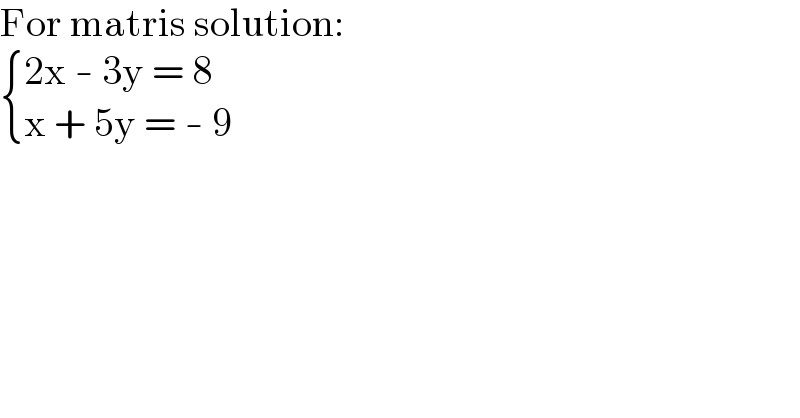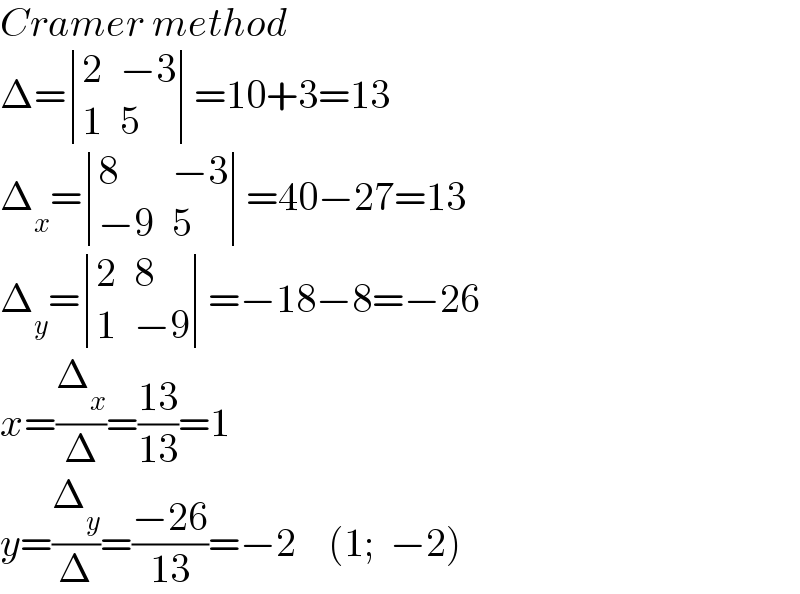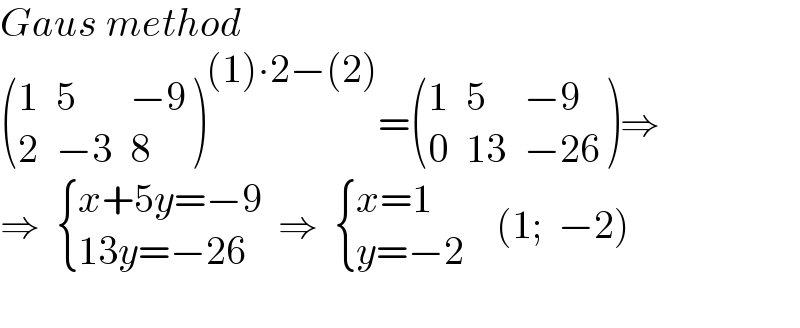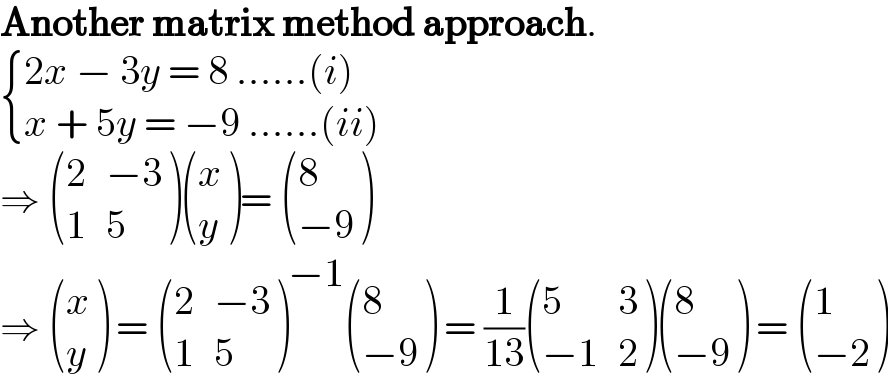
Question Number 150807 by mathdanisur last updated on 15/Aug/21

$$\mathrm{For}\:\mathrm{matris}\:\mathrm{solution}: \\ $$$$\begin{cases}{\mathrm{2x}\:-\:\mathrm{3y}\:=\:\mathrm{8}}\\{\mathrm{x}\:+\:\mathrm{5y}\:=\:-\:\mathrm{9}}\end{cases} \\ $$
Answered by maged last updated on 15/Aug/21

$$\Delta=\mid\underbrace{ } \\ $$
Answered by amin96 last updated on 15/Aug/21

$${Cramer}\:{method} \\ $$$$\Delta=\begin{vmatrix}{\mathrm{2}}&{−\mathrm{3}}\\{\mathrm{1}}&{\mathrm{5}}\end{vmatrix}=\mathrm{10}+\mathrm{3}=\mathrm{13} \\ $$$$\Delta_{{x}} =\begin{vmatrix}{\mathrm{8}}&{−\mathrm{3}}\\{−\mathrm{9}}&{\mathrm{5}}\end{vmatrix}=\mathrm{40}−\mathrm{27}=\mathrm{13} \\ $$$$\Delta_{{y}} =\begin{vmatrix}{\mathrm{2}}&{\mathrm{8}}\\{\mathrm{1}}&{−\mathrm{9}}\end{vmatrix}=−\mathrm{18}−\mathrm{8}=−\mathrm{26} \\ $$$${x}=\frac{\Delta_{{x}} }{\Delta}=\frac{\mathrm{13}}{\mathrm{13}}=\mathrm{1} \\ $$$${y}=\frac{\Delta_{{y}} }{\Delta}=\frac{−\mathrm{26}}{\mathrm{13}}=−\mathrm{2}\:\:\:\:\left(\mathrm{1};\:\:−\mathrm{2}\right) \\ $$
Commented by mathdanisur last updated on 15/Aug/21

$$\mathrm{cool}\:\mathrm{thanks}\:\mathrm{Ser} \\ $$
Commented by puissant last updated on 15/Aug/21

$${nice}\:{sir}\:{Cramer}\:{method}.. \\ $$
Answered by amin96 last updated on 15/Aug/21

$${Gaus}\:{method} \\ $$$$\begin{pmatrix}{\mathrm{1}}&{\mathrm{5}}&{−\mathrm{9}}\\{\mathrm{2}}&{−\mathrm{3}}&{\mathrm{8}}\end{pmatrix}^{\left(\mathrm{1}\right)\centerdot\mathrm{2}−\left(\mathrm{2}\right)} =\begin{pmatrix}{\mathrm{1}}&{\mathrm{5}}&{−\mathrm{9}}\\{\mathrm{0}}&{\mathrm{13}}&{−\mathrm{26}}\end{pmatrix}\Rightarrow \\ $$$$\Rightarrow\:\:\begin{cases}{{x}+\mathrm{5}{y}=−\mathrm{9}}\\{\mathrm{13}{y}=−\mathrm{26}}\end{cases}\:\:\Rightarrow\:\:\begin{cases}{{x}=\mathrm{1}}\\{{y}=−\mathrm{2}}\end{cases}\:\:\:\:\left(\mathrm{1};\:\:−\mathrm{2}\right) \\ $$$$ \\ $$
Commented by mathdanisur last updated on 15/Aug/21

$$\mathrm{cool}\:\mathrm{thankyou}\:\mathrm{Ser} \\ $$
Answered by maged last updated on 15/Aug/21

$$ \\ $$
Answered by physicstutes last updated on 16/Aug/21

$$\boldsymbol{\mathrm{Another}}\:\boldsymbol{\mathrm{matrix}}\:\boldsymbol{\mathrm{method}}\:\boldsymbol{\mathrm{approach}}. \\ $$$$\begin{cases}{\mathrm{2}{x}\:−\:\mathrm{3}{y}\:=\:\mathrm{8}\:......\left({i}\right)}\\{{x}\:+\:\mathrm{5}{y}\:=\:−\mathrm{9}\:......\left({ii}\right)}\end{cases} \\ $$$$\Rightarrow\:\begin{pmatrix}{\mathrm{2}}&{−\mathrm{3}}\\{\mathrm{1}}&{\mathrm{5}}\end{pmatrix}\begin{pmatrix}{{x}}\\{{y}}\end{pmatrix}=\:\begin{pmatrix}{\mathrm{8}}\\{−\mathrm{9}}\end{pmatrix} \\ $$$$\Rightarrow\:\begin{pmatrix}{{x}}\\{{y}}\end{pmatrix}\:=\:\begin{pmatrix}{\mathrm{2}}&{−\mathrm{3}}\\{\mathrm{1}}&{\mathrm{5}}\end{pmatrix}^{−\mathrm{1}} \begin{pmatrix}{\mathrm{8}}\\{−\mathrm{9}}\end{pmatrix}\:=\:\frac{\mathrm{1}}{\mathrm{13}}\begin{pmatrix}{\mathrm{5}}&{\mathrm{3}}\\{−\mathrm{1}}&{\mathrm{2}}\end{pmatrix}\begin{pmatrix}{\mathrm{8}}\\{−\mathrm{9}}\end{pmatrix}\:=\:\begin{pmatrix}{\mathrm{1}}\\{−\mathrm{2}}\end{pmatrix} \\ $$
